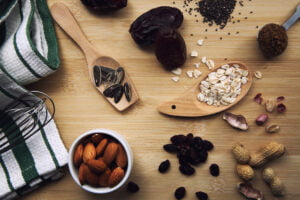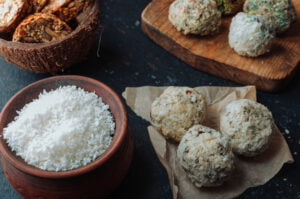Healthy toddler energy balls are a fantastic way to provide your little ones with the sustained energy they need to power through their active days. With the right combination of nutrient-rich ingredients, these tasty snacks can not only keep your toddlers satisfied but also support their healthy growth and development.
As parents, we all know that toddlers are bundles of energy. They’re constantly on the move, exploring the world around them, and learning at an astonishing rate. To keep up with their boundless curiosity and high activity levels, toddlers require nutrient-dense snacks that not only satisfy their taste buds but also nourish their growing bodies. That’s where healthy toddler energy balls come into play – a tasty and convenient solution to keep your little ones fueled throughout the day.
Table of Contents
- What Are Toddler Energy Balls?
- Simple Ingredients for Healthy Toddler Energy Balls
- Instructions to make no bake energy bites

What Are Toddler Energy Balls?
Toddler energy balls are small, bite-sized snacks made from a combination of nutritious ingredients such as whole grains, nuts, seeds, dried fruits, and other wholesome additions. These ingredients are typically blended together, rolled into compact balls, and sometimes refrigerated to set. The result is a delicious and portable snack that provides a burst of energy for your little explorers.
The Benefits of Toddler Energy Balls
- Nutrient-Dense: Healthy toddler energy balls are packed with essential nutrients that toddlers need for healthy growth and development. They often contain a variety of vitamins, minerals, healthy fats, and fiber to support their overall well-being.
- Sustained Energy: Unlike sugary snacks and treats, energy balls provide a more sustained release of energy. The combination of complex carbohydrates and healthy fats helps to keep your toddler energized and satiated for longer periods.
- Portability: These bite-sized snacks are perfect for families on the go. Whether you’re heading to the park, on a play date, or running errands, energy balls can be easily stashed in a bag for quick access when hunger strikes.
- Easy to Customize: One of the best things about toddler energy balls is their versatility. You can easily tailor the ingredients to suit your child’s taste preferences and dietary needs. If your little one has allergies, simply swap out specific ingredients to accommodate their sensitivities.
- Encourage Healthy Eating Habits: Introducing healthy snacks from an early age can foster positive eating habits in toddlers. By offering them nutrient-rich energy balls, you’re helping them develop a taste for wholesome foods, which can have a long-lasting impact on their diet as they grow.
Nutrient-Rich Ingredients to Consider
When making toddler energy balls, consider incorporating some of these nutrient-rich ingredients:
- Oats: A great source of complex carbohydrates, fiber, and essential nutrients like iron and zinc.
- Nuts and Seeds: Provide healthy fats, protein, and various vitamins and minerals. Almonds, walnuts, chia seeds, and flax-seeds are excellent options.
- Dried Fruits: Naturally sweet and rich in fiber, vitamins, and minerals. Dates, raisins, and apricots are popular choices.
- Nut Butters: Adds creaminess and healthy fats. Opt for peanut butter, almond butter, or sunflower seed butter if your toddler isn’t allergic to nuts.
- Honey or Maple Syrup: For natural sweetness and to help bind the ingredients together.
- Coconut: Adds flavor and texture while providing medium-chain triglycerides (MCTs) for quick energy.
- Cocoa Powder or Cacao Nibs: For a touch of chocolatey goodness with added antioxidants.

Simple Ingredients for Healthy Toddler Energy Balls
Here’s a basic recipe to get you started, but feel free to get creative and adjust the ingredients as needed:
- 1 cup rolled oats
- ½ cup nut butter (peanut, almond, etc.)
- ½ cup ground flax-seeds
- ½ cup dried fruits (raisins, dates, apricots, etc.), finely chopped
- ¼ cup shredded coconut
- 1 teaspoon vanilla extract
- Pinch of salt
- Optional: cacao nibs, mini chocolate chips, or other add-ins of your choice.
Instructions to make no bake energy bites
Here are the simple steps to make the no bake energy bites:
- In a large mixing bowl, combine all the ingredients and mix well until evenly incorporated.
- Cover the bowl and refrigerate for about 30 minutes to make the mixture easier to handle.
- Once chilled, take small portions of the mixture and roll them into bite-sized balls between your palms.
- Place the energy balls on a baking sheet lined with parchment paper and refrigerate for an additional 30 minutes to firm up.
- Transfer the energy balls to an airtight container and store in the refrigerator for up to a week. Alternatively, you can freeze them for longer shelf life.
Other helpful snack recipes for toddler
FAQs – Healthy energy balls
Do energy balls give you energy?
Yes, energy balls can provide you with energy, but it’s essential to understand how they do so.
Energy balls are typically made with nutrient-dense ingredients such as oats, nuts, seeds, dried fruits, and sometimes sweeteners like honey or maple syrup. These ingredients contain a mix of carbohydrates, healthy fats, and proteins, which are the primary sources of energy for our bodies.
- Carbohydrates: Carbohydrates are the body’s primary source of quick energy. When you consume energy balls that contain ingredients like oats, dried fruits, or honey, your body breaks down the carbohydrates into glucose, which is then used by the muscles and other tissues for energy.
- Healthy Fats: Fats are a concentrated source of energy and are particularly useful for providing long-lasting energy. Ingredients like nuts, seeds, and nut butters in energy balls contain healthy fats like monounsaturated and polyunsaturated fats, which can provide sustained energy.
- Proteins: While the primary role of proteins is to build and repair tissues in the body, they can also contribute to energy production, especially during prolonged physical activity or when carbohydrates are scarce. Some energy balls may contain protein-rich ingredients like nuts or seeds, which can provide a slight boost in energy.
It’s important to note that the overall energy you get from energy balls will depend on the specific ingredients used and the portion size you consume. They are not meant to replace balanced meals but rather to provide a convenient and nutritious snack to keep you fueled between meals or during physical activities.
Energy balls can be a healthier alternative to many store-bought snacks that are high in refined sugars and unhealthy fats. However, like any food, moderation is key. While energy balls can be a great source of energy, be mindful of portion sizes and the rest of your diet to maintain a balanced and healthy lifestyle.
How healthy are protein balls?
Protein balls can be a healthy snack option, but like any food, it depends on the specific ingredients and how they fit into your overall diet and lifestyle. Here are some factors to consider when assessing the healthiness of protein balls:
1. Protein Content: Protein balls are typically designed to be higher in protein than other snacks, which can be beneficial for maintaining muscle mass, supporting tissue repair, and keeping you feeling full and satisfied. Protein helps stabilize blood sugar levels, reducing the likelihood of energy crashes and cravings between meals.
2. Nutrient Density: The healthiness of protein balls largely depends on the ingredients used. If they contain wholesome, nutrient-dense components such as nuts, seeds, whole grains, and natural sweeteners like honey or dates, they can offer valuable vitamins, minerals, and antioxidants.
3. Healthy Fats: Many protein balls include nuts, seeds, or nut butter, which provide healthy fats like monounsaturated and polyunsaturated fats. These fats are essential for various bodily functions, including brain health and hormone production.
4. Low Added Sugars: Some protein balls can be high in added sugars if they contain a lot of sweeteners like honey, maple syrup, or even chocolate chips. While natural sweeteners can be healthier than refined sugars, it’s still crucial to moderate the overall sugar content.
5. Calorie Content: Protein balls are calorie-dense due to their concentrated ingredients. While this can be advantageous for active individuals or those needing a quick energy boost, it’s essential to be mindful of portion sizes, especially if you’re trying to manage your weight.
6. Personal Dietary Needs: The healthiness of protein balls also depends on individual dietary preferences and restrictions. For example, some people may need to avoid nuts due to allergies, while others may prefer vegan or gluten-free options.
7. Moderation: While protein balls can be a nutritious addition to your diet, they should be enjoyed in moderation. Eating them in excessive amounts may lead to consuming more calories or nutrients than your body needs.
DIY Protein Balls: A Healthier Option
One of the significant benefits of protein balls is that you can make them at home, giving you control over the ingredients and their quantities. This way, you can customize the recipe to suit your taste preferences and dietary needs.
When preparing homemade protein balls, consider using a mix of nuts, seeds, whole grains, dried fruits, and natural sweeteners to ensure a balance of nutrients and flavors. You can also experiment with different spices, like cinnamon or cocoa powder, for added taste without added sugars.

What is inside an energy ball?
The ingredients inside an energy ball can vary depending on the recipe and personal preferences. However, the primary components of energy balls typically include a combination of the following nutritious ingredients:
- Oats: Rolled oats are a common base for energy balls. They provide complex carbohydrates, fiber, and essential vitamins and minerals.
- Nuts: Almonds, walnuts, cashews, or other nuts are often used to add healthy fats, protein, and various nutrients like vitamin E and magnesium.
- Seeds: Chia seeds, flaxseeds, pumpkin seeds, or sunflower seeds are excellent sources of healthy fats, protein, and essential minerals like iron and zinc.
- Dried Fruits: Dates, raisins, apricots, or cranberries are popular choices for natural sweetness and to bind the ingredients together. Dried fruits also provide vitamins, minerals, and fiber.
- Nut Butters: Peanut butter, almond butter, or other nut or seed butters add creaminess and additional healthy fats and protein.
- Sweeteners: Natural sweeteners like honey, maple syrup, or agave nectar are sometimes added to enhance the taste and stickiness of the mixture.
- Flavorings: Vanilla extract, cocoa powder, or spices like cinnamon can be included to add extra flavor to the energy balls.
- Optional Add-ins: Depending on the recipe and individual preferences, energy balls may include other ingredients like shredded coconut, cacao nibs, mini chocolate chips, protein powder, or dried spices.
To prepare energy balls, the ingredients are typically combined in a food processor or blender until well mixed and slightly sticky. The mixture is then rolled into bite-sized balls, which are often chilled in the refrigerator to firm up before serving.
The versatility of energy ball recipes allows for various combinations, making it easy to customize them to suit dietary preferences, allergies, or specific nutritional requirements. As they are often no-bake snacks, they provide a convenient and healthy option for a quick energy boost or satisfying snack on the go.
How long do energy balls last in the fridge?
The shelf life of energy balls in the fridge can vary depending on the specific ingredients used and the recipe. However, in general, energy balls can last for about 1 to 2 weeks when stored properly in the refrigerator.
To maximize the freshness and extend the shelf life of energy balls, follow these guidelines:
- Store in an Airtight Container: Place the energy balls in an airtight container to prevent them from absorbing odors from other foods in the fridge and to keep them from drying out.
- Keep Refrigerated: Energy balls should always be stored in the refrigerator, as the cold temperature helps slow down the growth of bacteria and extends their freshness.
- Check Ingredients: If your energy balls contain ingredients like fresh fruits or dairy products (e.g., Greek yogurt), they may have a shorter shelf life and should be consumed within a few days.
- Monitor Texture and Smell: Pay attention to any changes in the texture or smell of the energy balls. If they become overly dry, hard, or develop an off smell, it’s best not to consume them.
- Consider Freezing: If you’ve made a large batch of energy balls and don’t think you’ll finish them within the recommended timeframe, you can freeze them for longer storage. Simply place the energy balls in an airtight container or resealable freezer bags and store them in the freezer for up to 2 to 3 months. Thaw them in the refrigerator before eating.
Remember that homemade energy balls made with natural ingredients may have a shorter shelf life compared to store-bought processed snacks, which often contain preservatives. While energy balls are a nutritious and convenient snack, it’s essential to be mindful of their freshness and consume them within the recommended storage timeframe for the best taste and quality.


1 thought on “#1 Easy Healthy toddler energy balls |No bake”